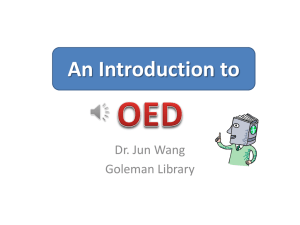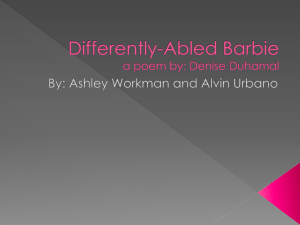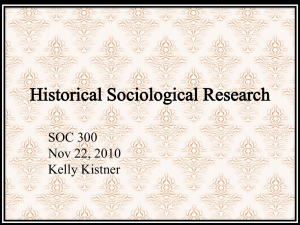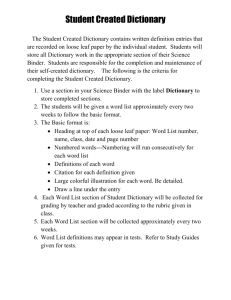What has the OED become
advertisement
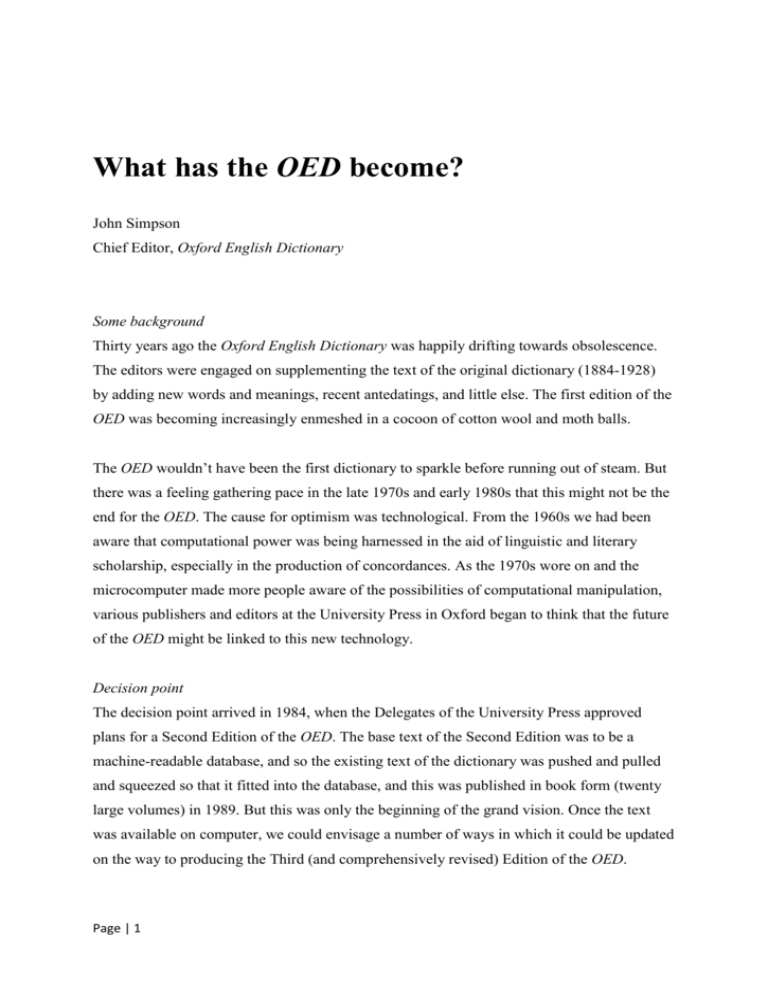
What has the OED become? John Simpson Chief Editor, Oxford English Dictionary Some background Thirty years ago the Oxford English Dictionary was happily drifting towards obsolescence. The editors were engaged on supplementing the text of the original dictionary (1884-1928) by adding new words and meanings, recent antedatings, and little else. The first edition of the OED was becoming increasingly enmeshed in a cocoon of cotton wool and moth balls. The OED wouldn’t have been the first dictionary to sparkle before running out of steam. But there was a feeling gathering pace in the late 1970s and early 1980s that this might not be the end for the OED. The cause for optimism was technological. From the 1960s we had been aware that computational power was being harnessed in the aid of linguistic and literary scholarship, especially in the production of concordances. As the 1970s wore on and the microcomputer made more people aware of the possibilities of computational manipulation, various publishers and editors at the University Press in Oxford began to think that the future of the OED might be linked to this new technology. Decision point The decision point arrived in 1984, when the Delegates of the University Press approved plans for a Second Edition of the OED. The base text of the Second Edition was to be a machine-readable database, and so the existing text of the dictionary was pushed and pulled and squeezed so that it fitted into the database, and this was published in book form (twenty large volumes) in 1989. But this was only the beginning of the grand vision. Once the text was available on computer, we could envisage a number of ways in which it could be updated on the way to producing the Third (and comprehensively revised) Edition of the OED. Page | 1 The old vision would have seen the production of supplement upon supplement of the dictionary, each one gradually making life more difficult for the user as yet more instalments had to be examined to ensure that all relevant material had been checked. The University Press was not prepared to countenance that route. Editorially the supplement model is problematic too, as the overall profile of an entry is not improvement by piecemeal additions – accessory coat hangers added to what was a self-consistent whole. Furthermore, the dictionary is too important for only part of it (say, the modern component) to be maintained. Modern vocabulary and word use depends on that of the past: the picture would misrepresent lexical development if we were to update the present at the expense of the past. What was the medium of the future? We thought about what the OED could become, knowing that our ideas would certainly change as time went by. Our first plan was to use the machine-readable text of the dictionary as a platform from which to produce a revised CD-ROM (which represented the advanced technology of the day). Whilst plans were being made for bringing this about, we started to tussle with the problems of a new editorial policy: one which would drag the OED from being a dinosaur of the nineteenth century to becoming an icon of the twenty-first. As the twenty-first century loomed, we recognized that the role of the CD-ROM was dimming, and that its place was being taken by the world of the Internet. Fortunately the dictionary had originally been coded in a common-form mark-up language, SGML, and this could be updated in due course to new standards, such as XML. And then as the OED settled down to life online, we became aware of the potential of phones and other devices smaller than the pc or the laptop on which the OED might perform. The OED is in a position to metamorphose with the technology. The grand vision The mechanics of the database are less important, though, than the vision. What could the OED become? At first we thought of the OED as the central, pivotal database within a system of knowledge represented by text. Any user might encounter an issue which the OED might resolve, and Page | 2 would then leap from the text (of whatever sort) currently being consulted into the OED for the resolution of the problem. As time went on, we started to modify this approach, and to see the OED as one of a number of major textual and other resources which might form a network of support for the user in various contexts. Changing the text But before we look too far down the line, we should investigate what is happening to the dictionary on the editorial side. The Second Edition of the OED consisted of 21,000 pages of closely printed, triple-column text: a substantial text covering 240,000 headwords and a total of around 600,000 lemmas (many of which were embedded in larger entries). The majority of the text dated from the period of the First Edition of the dictionary (1884-1928), with additional material supplementary to the main text added in 1933 and between 1972 and 1986. The text therefore represented editorial thought from various different eras. Very early on we decided, along with the OED’s Advisory Committee of leading language scholars, that the only option available to us was to mount a comprehensive revision and update of the standing text. Anything short of this would not do justice to the fact that the words of the language had a beginning which needed reinvestigating, a middle period of development, and, in the cases of terms which have lapsed from use, a period of decline. Furthermore, words and meanings do not exist in a vacuum. They form part of a semantic network and the relationship between nodes of this network (the individual words and meanings) is in a constant state of flux. If we were to address only part of this vast network, we might do justice to individual words, but we would not do justice to the language. As a result, all aspects of each entry are reviewed during the process of revision. It is surprising how often the form of the headword changes, in a language where we think spelling is reasonably consistent. But reviewing a word after one hundred years – which is often the case here – reveals significant changes in hyphenation practice, in the most familiar spelling of words which have entered English from other languages, and in innumerable other minor ways. Page | 3 Much the same can be said about pronunciation. The First Edition of the dictionary employed a system of phonetic representation devised by the original editor, James Murray. This was maintained through the final supplement of 1972-86, but was replaced in 1989 by a variety of the International Phonetic Alphabet. In addition to the ‘Received Pronunciation’ provided by the OED, the revised entries introduced a General American pronunciation as well as other regional varieties when particular words demanded this. And we have changed our speech patterns in many ways since the era of the First Edition of the dictionary. Both the typical quality of some vowels, and the stress-patterning of many words, has altered surreptitiously over the last hundred years, and the editors need to resolve these changes, without forgetting the older realizations. Definitions are reviewed in the light of new evidence and changing resources; etymologies benefit from the discoveries of scholars over the past century, and from the reinvestigation carried out by the OED’s own etymological team. Changes, by any of the OED’s seventy or so editors, are typically submitted to external scholars for review. Perhaps the most significant changes occur in the realm of documentation, and approximately 60% of the words and meanings in the dictionary are now being provided with earlier attestations as a result of the work being done by editors and also by the wider research and general community interested in improving the documentary quality of the dictionary. A series of ‘before’ and ‘after’ snapshots of OED entries (‘Rewriting the OED’) is currently available for consultation on the OED’s web site: http://www.oed.com/staticfiles/Rewriting theOED.pdf. This proceeds through each aspect of an entry, and explains what sorts of changes have been made. Revised and updated entries are published every three months on the dictionary’s home web site: oed.com. We can look at a short entry (in this case market garden) to obtain a detailed view of how it has changed during the process of revision. Market garden: how has the entry altered after review and update? This is how the entry appeared in the First and Second Editions of the OED: Page | 4 We can see that the definition is tucked away alongside many other compounds of MARKET n., and is separated physically from its accompanying illustrative quotations, which appear some distance further on in the entry for MARKET n.: Deep within this extensive block of quotations it is possible to establish that the First Edition of the OED provided two contextual examples of the expression market garden, the earliest from the Penny Cyclopaedia of 1840 (the same source provides the first attestation of market gardener), and another (from Dickens) dated 1865. Nowadays, a moment’s reflection will prompt the realization that a term such as market garden (and indeed market gardener) is unlikely to have first seen the light of day in a general-purpose encyclopaedia – no matter how up to date the encyclopaedia liked to think that it was. This is of course an issue with any historical dictionary with its origins set firmly in the nineteenth century. The language is so large, and the availability of researchers (even in the leisured days of the nineteenth century) so restricted, that it was often the case that evidence was taken from a reasonably modest selection of sources. This tended to give the impression that these sources (often canonical writers or standard reference texts) had more influence on lexical innovation than was actually the case. The problem can never be entirely overcome, but modern access to raw data on the language helps to ameliorate matters. Ultimately any dictionary relies on the good sense of its readers to interpret the information it provides. So after one hundred years or so, how did market garden progress? Here is the revised entry as it first appeared in the year 2000: market garden Brit. /ˌmɑːkɪt ˈgɑːdn/, U.S. /ˈmɑrkət ˌgɑrdən/ [< MARKET + GARDEN , after market gardener .] A piece of land on which fruit and vegetables are grown to be sold commercially. See also market gardener. Now more commonly known in the United States as a truck-farm (see TRUCK 5). Page | 5 1811 J. MEASE Picture of Philadelphia 349 [There are] extensive market gardens, and several handsome summer retreats. 1865 DICKENS Our Mutual Friend I. ii. i. 164 Where the railways still bestride the market-gardens that will soon die under them. 1886 J. F. CONIGRAVE S. Austral. 80 The market gardens range from three or four acres in the rich peaty bottoms of gullies up to thirty, and even fifty acres. 1923 R. HERRICK Homely Lilla 197, I can get a job in a market garden. 1948 G. D. H. BELL Cultivated Plants of Farm xiv. 129 Many of them are still regarded as market-garden crops. 1987 Cornwall Rev. July 12/1 The surrounding countryside is renowned for the earliest market garden produce in mainland Britain. By this point we can see that the term has been deemed important enough to have its own entry (market gardener and market gardening have similarly been ‘upgraded’ to main-entry status). The headword form (spelling) has changed: there is now no hyphen in market garden, according to the majority of the evidence available to the editors. A formal etymology and pronunciation have been provided: in this case these are quite formulaic, as there appear to be no additional complications; but the systematic presence of etymologies and pronunciations facilitates subsequent computational analysis and interpretation. The definition has been altered slightly, at bottom in response to societal changes since the date of the First Edition of the dictionary. Finally a more extensive block of documentary evidence has been provided which shows, as we suspected, that the term market garden did not first see the light of day in the pages of the Penny Cyclopaedia, but has a prehistory in more common-or-garden texts. In this case it is evidenced from James Mease’s Picture of Philadelphia, first published in 1811. The documentation is now taken well beyond Dickens and 1865 up to the present day, from a variety of types of sources (i.e. not simply canonical authors and reference texts). One of the advantages of online publication is that we are able to respond to improvements suggested by readers of the dictionary. There must be many people interested in market gardening in the big world, because since the year 2000 the entry has been updated a number of times, and we can see that several improvements have been made. Page | 6 The principal improvement relates to the early documentation for the expression. As time passed after the first release of the revised entry we received notification that market garden could be found towards the end of the eighteenth century in the Proceedings of the Old Bailey. This remarkable source is available at http://www.oldbaileyonline.org/, and has already provided over forty new first references for the OED for words relating to everyday life and crime in London mainly in the eighteenth and nineteenth centuries. Examples include marine store, rag-and-bone picker, and timekeeper (in a sports context). Page | 7 But then, once that example from 1793 had been installed as the earliest reference, we were notified about Batty Langley’s use of the expression in his New Principles of Gardening (1727). Langley was something of an eccentric garden designer, and it is not surprising that a new term of this nature finds a place in his work. But even now a single new discovery might take our knowledge of the word back even further. At much the same time (2007) an equivalent quotation from Langley’s text was added to the entry for market gardening. The other change to market garden since original revision is that the 1865 Dickens quotation has (along with many other quotations from the same source) been redated to 1864, in line with its first publication in periodical form. These are the sorts of changes which are happening to OED entries both as they pass through the process of revision, and subsequently. The intention is to revise and maintain the OED as a dynamic resource which can respond rapidly both to actual changes in the language and to the emergence of new information about older features of the language. Benefits of online publication The previous section has mentioned some of the benefits of online publication. There are others as well. Overall, the advantages of online publication include: the ability (on the part of editors) to be in control of the form of the entry at any stage in the editorial process the option (on the part of editorial managers) to select those entries or entry ranges for editing according to any of a number of criteria, from across the whole sweep of the dictionary (rather than in a narrow alphabetical range) the choice to publish only those entries which the publisher wishes to publish at any one time (for whatever reason) the use of tools which manage the workflow of the editorial process and report on any aspect of this the chance to re-edit material after it has been revised and published, in response to new discoveries the facility to alter the display, processing procedures, structure, tagging, or any other feature of the background software in response to external circumstances the maintenance of online communication with academic consultants and other contributors to the dictionary Page | 8 These are some of the more traditional advantages of online working. We are finding out about others as we move onwards. How does this all fit in with the philosophy of the OED? The OED is a historical dictionary; its original title page stated that it was based ‘on historical principles’. It looks at words over time, plotting changes as they occur. It looks back from the point or points at which a borrowed word enters English to the language from which it came, seeking for the semantic genes that it brought with it. It asks (silently, but emphatically all the same) why a word or a sense arose when it did: what were the conditions within the language and within the society which used that language that were favourable to the introduction of the term? And most importantly, it looks for logical consistency in the changes which a word experiences over time. We don’t expect changes to happen for no apparent reason. Changes cannot be predicted but they can normally be explained. The word cell is helpful in explaining something of the philosophy of the OED. There are three nouns and one verb in English spelt cell, and we will look at the earliest of the nouns (containing senses such as a monk’s room, a small group of revolutionaries, and the fundamental unit of living organisms consisting of protoplasm encased within a membrane). Even a short review of the range of meanings of cell brings home to us the semantic breadth that the word encompasses. Words normally only achieve such breadth after many years of development in the language. And this is the case with cell. It was introduced into English in the Old English, pre-Conquest, period from Classical Latin cella, later reinforced by various French forms of the word. The ‘standard’ French form celle is no longer common in French, having been superseded earlier by cellule (from which we obtained yet another word). That, of course, is largely irrelevant once the word is embedded in English. From our point of view it is very relevant that most of the meanings of the word to do with rooms or chambers already existed in Latin and French before the term took hold in English. We were simply taking over an existing word in existing meanings, and were not witnessing illogical, inexplicable change. Even the later senses ‘a honeycomb’ and ‘a compartment of the brain’ predate their English use in these donor languages. These meanings in turn seeped from Latin into later Romance languages across Europe. What we see as a major Page | 9 development in English was in fact happening throughout Europe along the established pathways of diffusion. So even this pre-English section of the entry for cell touches on a fundamental principle of the OED: words very rarely arrive out of nowhere. They metamorphose, from other languages or in parallel with similar uses in other languages, or as a result of interaction within English, or in response to changes in the society or culture that uses them. What we are looking at is an interdependent network of lexical features. The editor’s task is to piece together the individual aspects of a word, and let it take its place in the interlocking analysis of language represented by an online dictionary. The OED’s entry for cell includes a graphical summary of its development within English, available online. Here is that representation as it appeared in December 2011: Page | 10 The graph shows the twenty-two major sub-senses of cell (in the vertical axis) plotted against time (in the horizontal axis). The bar representing the earliest sense (“a dwelling consisting of a single chamber inhabited by a hermit or anchorite”) travels from the far left to the extreme right, depicting use all the way from the Old English period into the twenty-first century. The bar for the second sense (“a monastery or nunnery, generally of small size, dependent on some larger house”) is slightly indented – indicating that it is first recorded slightly later, in the late Old English period – and again ranges across to the present day. The entry has been structured in two major branches: senses 1-6 cover cells which are rooms or chambers; senses 7-22 cover extended uses. The sub-senses have been ordered, within this structure, according to their date of earliest recorded use. As a result one would expect the graph to taper towards the bottom right-hand corner. One surprising feature is that once a sub-sense starts, it normally continues through to the present day (even though in fact the sense may now be archaic or historical in use). There is not much evidence, for this particular common word, of sub-senses dying out on their march to the present day: this happens to two of the six ‘room’ senses and only one of the sixteen extended uses. Indeed, that particular extended use is a poorly attested use of uncertain meaning. The first branch of meanings (sense 1-6) portrays a semantic development from a single room (inhabited by a hermit) to a monastery or nunnery which is dependent on a larger house. As the Middle Ages evolve, we find a new sense, taking aspects of these earlier uses – any of many single rooms in a monastery or nunnery occupied by a member of the religious community. The Middle English religious usages remain important features of the word, and we wait till the eighteenth century for the next major development of the ‘room’ meaning. By the eighteenth century prison reformers were looking for a term to describe the new solitary rooms designed in forward-thinking prisons. Cell was the obvious term: prisoners were to be held isolated in rooms regarded as comparable to a monk’s cell. Each individual cell was one of a large number of such chambers within the prison. Changes in society and its thinking about prisons fostered a change in the language which has endured to the present day. Page | 11 The other branch of meanings for cell relates to things which are not room or chambers, but were considered to share some of the characteristics of these. The graph above shows the word cell had existed in English for several hundred years before this new branch developed. But after a while we start to find cell being applied in new circumstances: to any of the tiny compartments imagined to exist (according to medieval doctors) in the brain. The concept of a cell being one of a number of small compartments was simply transferred (in various European languages) from the context of buildings to the architecture of the brain. Similarly the word cell was applied to the compartments of a honeycomb – rather like the cells in a monastery seen through a reducing glass. Throughout this development over time the OED expects to find a logical (or at least an understandable) connection between sequentially related sub-senses. The motivation for a new sense may be external (new technology, historical events, etc.), but the new sense is normally just an extension of something that already exists – with a new twist. As early as the late Middle Ages cell took on a wider meaning in medical science, as it came to mean any large chamber in the structure of a tissue or organism. With the invention of the telescope there was further room for cell to expand, this time to describe the cavities and chambers scientists such as Hooke could see through their new magnifying devices. Once cell became associated with microscopic science, it experienced several metamorphoses in the Renaissance within the same semantic area until finally becoming the key word in the burgeoning biological sciences of the early nineteenth century: ‘the fundamental, usually microscopic, structural and functional unit of all living organisms, which consists of a small quantity of protoplasm enclosed within a membrane, typically contains a nucleus or nucleoid and other organelles and internal compartments, and is capable of utilizing energy, synthesizing proteins and other biomolecules, and (usually) replicating itself’. Subsequent changes took cell into the world of computing and mobile (‘cell’) phones. Cell, therefore, has existed in the English language for well over one thousand years. During that time it has developed from a set of related meanings centred around ‘room’ or ‘chamber’, recorded first in the Old and Middle English periods, to become one of the key words of modern biological science and mobile-phone technology, by way of a linked set of submeanings which move us semantically through different compartments and cavities that were significant at different periods of the word’s history. Generally speaking, comparable Page | 12 developments can be identified throughout the vocabulary of any language observed over time. It’s one of the ways language works. Has the role of the editor changed over the last one hundred years? There are many ways in which the editor’s job has remained virtually unchanged over the lifetime of the OED. However the documentary evidence for the language is obtained and analysed (on index cards or on-screen; by organizing slips of paper in different piles or through computational analysis of syntax and meaning), the editor still needs to apply much the same thought processes to the data today as one hundred years ago. Many little facts have to be reviewed in order to build the big picture of a word; apparent logical or chronological inconsistencies in semantic development have to be re-examined and explained; definitions have to be written elegantly but accurately; there is not time to extend research on a word or a meaning beyond practical limits, or nothing will ever be completed. We work on the assumption that we complete as much work on a word as we can, as rapidly as we can, and then review and publish the result. There will be times when further information might improve the entry, but it would be impractical to extend the research to encompass this possible gain. Readers will identify gaps and will provide us with the intervening data. We can’t do everything ourselves, and it would be presumptuous to think that we could. Editors from the original edition of the OED in the late nineteenth century would not have a great deal of difficulty accommodating themselves to work on the twenty-first century OED, once they had assimilated the enormous cultural changes since their time. The principal differences are indeed the cultural perspective, which includes a less Britain-centred editorial perspective, and the sense that the editor is not working on a word in isolation, but on a word which forms part of a much larger network of language. The computer makes it easier to see this extended view. A new mode for searching the OED When the OED relaunched its online site in November 2010 it took advantage of the current search mode of using filters to narrow down results. This allowed the user to refine results in a way that was often possible on the former online system (available since 2000), but which involved very complex search routines. The new system had the benefit of simplicity. Page | 13 Combined with filtered searches, the relaunched web site was able to represent results of searches not only as a list of entries (or other category) which matched the search request, but also by means of timelines which offered the user a visual representation of the results. This compressed view typically gives an instant, visual, impression of the outcome of a search, which can in turn be refined according to other criteria. This timeline shows the user the dates at which words are recorded in the OED as entering English from the Scandinavian languages. There are a small number in the Old English period, then a significant mass from 1200 to 1450 AD, followed by a reduction but not complete absence in later centuries. The user is therefore asked to consider the underlying facts which cause this pattern to be created. Why, for example, are more words of Scandinavian origin recorded in English in the Middle Ages than in the Old English period when (from the history of Viking raids) we might expect to see a more dominant number. Page | 14 The answer lies elsewhere, in the mechanics of language transmission, in the power relationship of English with (Anglo-)French, etc. If we then employ a filter, and reduce this Scandinavian word set down to the Swedish words recorded as entering English, we find a different ‘shape’ to the graph: This shape shows that the heaviest period for the introduction of Swedish words (as opposed to those from the other Scandinavian languages) appears to be the late 19th century. Again, what are the reasons for this? How much do we need to discount the fact that this was the period just prior to the compilation of the First Edition of the OED? There are 123 words in this group, of which 66 are recorded as entering English between 1850 and 1950. What are these words? The 1850-1950 cohort includes a large number of minerals and chemicals (signifying the important of Sweden in that period in the geological and chemical sciences), Page | 15 along with various ‘cultural’ terms which found their way into English for a number of reasons – words such as Lapp, ombudsman, Riksdag, sloyd, smorgasbord, and trolldom. We can compare this set with the much smaller set (five) of Swedish words recorded as entering English in the period 1600-1650. What sort of words were these? They were: barling (a pole used in boat-building), gantlope, rot, skol, and trow. At this period we see a different prolife in the English perception of Sweden: military and sea-faring terms, drinking, and the hobgoblins of mythology. In different periods we see different influences on the interaction between peoples. The obscure Swedish loanword gantlope went on, after minor surgery, to have an illustrious career in the common or garden English expression ‘to run the gauntlet’. It would be extremely interesting to be able to view the comparable list of words borrowed into Swedish from English in those time periods. The online site presents a different picture of the data every three months, when the OED’s database is updated with newly revised and freshly written entries. So although these timeline graphs show the state of play in mid 2011, the equivalent graphs for 2012 will be perceptively different, as a result of new material, new analysis, fresh discoveries. Authorial innovation The filter and timeline system is not restricted to borrowed words. Another filter allows the user to see a chart of the thousand most frequently cited authors and sources in the dictionary. Again, this timeline needs interpretation: the output of a writer such an Jane Austen was (in terms of words) much lower than say that of Charles Dickens, so one would not expect to find Jane Austen as high on the chart as Dickens: in fact they stand at positions 13 and 251 out of 1,000 respectively, with Austen credited with the first recorded use of 44 words, and Dickens 258. The statistics on the chart change every three months, along with the rest of the dictionary data on the site, in line with the latest editorial alterations and additions. Page | 16 Here we are at the mid-point of the chart. The columns represent, in order: sequence number, name of source, date(-range) of source, total number of quotations, earliest quotation for a word, earliest quotation for a sense. From this it is possible to see, for example, that altogether Mary Wortley Montagu and Isaac D’Israeli are both cited around 900 times in the entire dictionary, they both have a low ratio of first usages (word and sense). George Turberville (the sixteenth-century writer of animal husbandry), however, has a much higher recorded innovation ratio. The reader may ponder the lexicographical and real reasons for these differences. One point that is a consistent feature of the revision is that the major, canonical authors of the language are gradually having their positions eroded. This is not to say that we think any less highly of them as literary figures, but that their hegemony is being rightly challenged by the mass of less literary sources to which editors can now turn for historical evidence of the language. Page | 17 Here is James Joyce’s ‘page’ on the OED Online web site. As of December 2011 it shows Joyce as the 144th most-cited ‘source’ in the OED. He has dropped one place since mid 2011, and I would expect the gradual slide to continue, as with almost all other celebrated writers. Joyce is currently shown as the first recorded reference for 483 words and meanings. During revision around 90 similar ‘first usages’ have been ‘lost’ to other sources, especially those newly available for searching on online historical databases. By contrast, new usages by the author find their way on to the database, buoying up but not maintaining his ranking. At time passes, we shall eventually have a far better view of the types of words and meanings where Joyce (and other canonical authors) are truly innovative. Crowdsourcing The OED has always crowd-sourced, encouraging people throughout the world to increase our knowledge of the language by contributing directly to the dictionary. As we think about ways in which the OED will develop in the future we consider the possibility of setting up a Page | 18 wiki, to allow people to post their own earlier quotations, comments on etymology or definition, etc. Early experiments with a web site designed for science-fiction enthusiasts, at whom anyone can contribute new material on the subject to the OED, have proved extremely useful. For several years people have been able to suggest new sci-fi usages, or to supplement existing ones, at http://www.jessesword.com/sf/. Here, for example, is the site’s record for meteor storm: Page | 19 The current online version of the entry for meteor shows the effect that work on this web site has had. The original version of meteor storm dated the expression from 1977, as the page above states. The page then continues to narrate the contributions provided by users of the site, on the way to providing the current earliest example of the term in 1872. As usual, we know that around the next corner lies yet another earliest example – for this or any other word. We are considering the possibility of increasing the number of these specialist sites, as well as offering a general facility to post new material on or in parallel with the main OED site. Extending the network Traditionally dictionaries link between related entries by means of cross-references. Online this mechanism can be enhanced by simple techniques such as pop-up windows showing the meaning to which a cross-reference is given (and therefore making it unnecessary in all cases to click through to the entry): Page | 20 Here we have an instance (at the entry for ROD n.) of a definition provided as only a crossreference to another entry. By floating the cursor over the entry online, it is possible to read the intended definition without having to migrate to the relevant page. Links by means of a thesaurus We are very fortunate that a new linking device, quite in keeping with the new idiom of linking around online web sites, has been provided for the OED by the compilation and publication of the Historical Thesaurus of the OED, a project initiated by Professor Samuels at the University of Glasgow and finally brought to fruition in 2009. The project sought to re-order the semantic landscape from a sequence which was wordbased and alphabetical to one which was concept-based, in the manner of a thesaurus. Since Page | 21 the project was dealing with the OED’s historical data, the objective could include the ordering of words chronologically by concept, so that all words in the dictionary with the general sense ‘spoon’ could be listed together, and the user could see when and how these usages entered and feel out of use in English. This is a snapshot of the online database which lists the thesaurus structure around the term ‘spoon’ as an item of cutlery. By clicking on ‘spoon…types of’ the user is taken to this list of types of spoon (illustrated here only up to the mid eighteenth century): Page | 22 At present ‘tea-spoon’ is recorded half a century before ‘tablespoon’, but various terms which are much less familiar (and which we might not have thought of consulting), such as ‘slip’ and ‘pap spoon’, are also shown too. The thesaurus module is an extremely strong ‘add-on’ to the OED, available to all users. It provides a new way of looking at the vocabulary of English across the centuries. And yet again, the data is updated every quarter, so that new discoveries will cause the display of data to change and better reflect the reality of the language today and in the past. A new view of the language What this new technology means is that we are able to revise and update the dictionary with a mass of detail unavailable to the original editors of the OED, and at the same time to present the information in new ways too. These new ways offer not just a look-up dictionary, in which finding the information looked up represents the end of the search. Rather, it presents Page | 23 the dictionary as a land of exploration, in which links are followed through a variety of different types of searches, and the network of language is much more successfully harnessed to provide answers not just to the little questions, but to larger questions to which the answers were previously entirely swamped by the mass of specific detail. Beyond this, we are now in a much better position to review users’ real uses for the dictionary, both as a guidepost in a system of online text and other data, but also as a repository for new information, provided perhaps through a wiki or other crowd-sourcing medium, which will allow the dictionary to become more accurate, and more dynamically respond to the needs of the user.1 1 Illustrations of the OED both online and in other formats are published by kind permission of the Secretary to the Delegates of Oxford University Press. Page | 24
